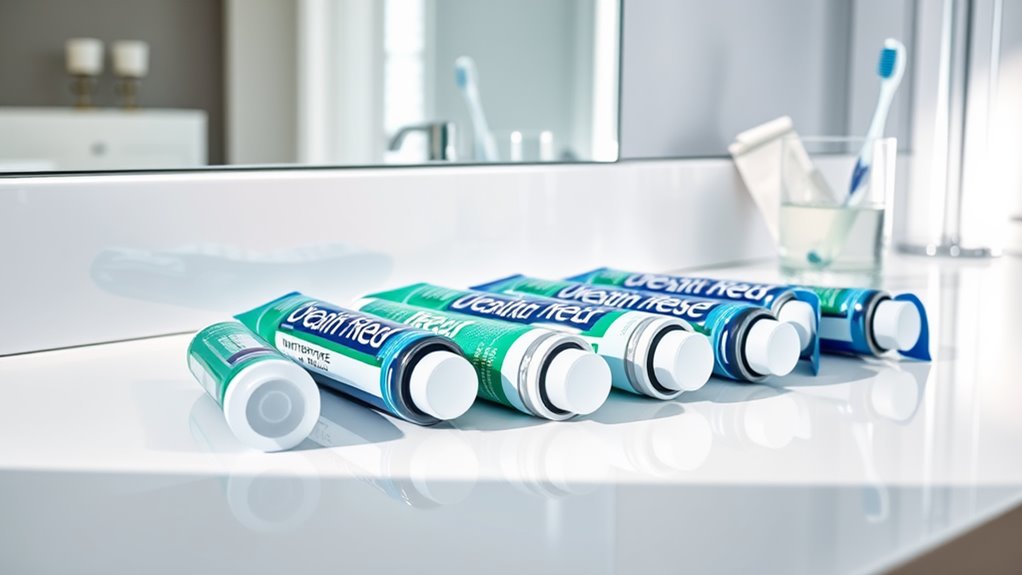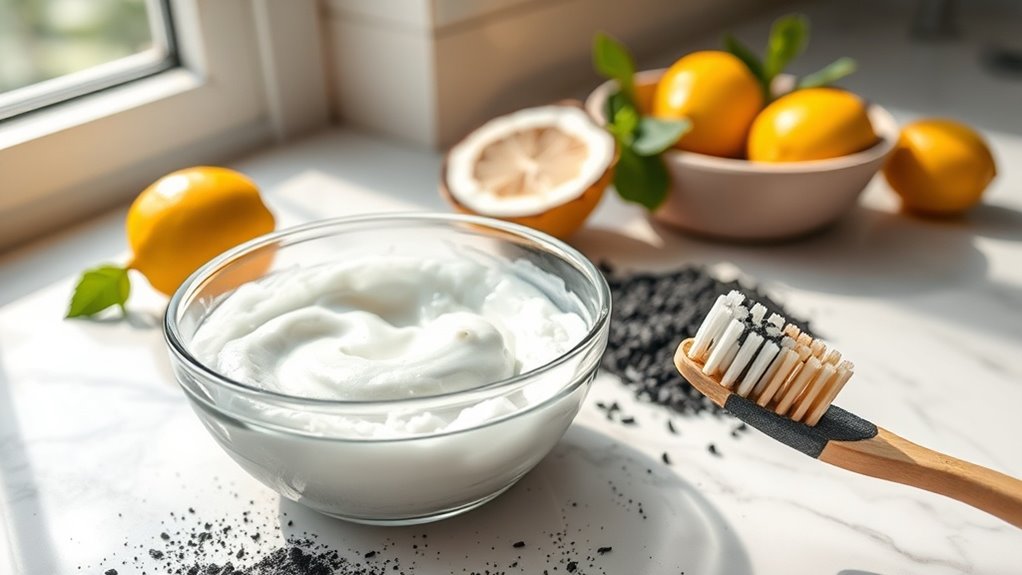Are Whitening Toothpastes Really Worth It.
Key Takeaways
- Whitening toothpastes can effectively remove surface stains but are less powerful than professional whitening treatments.
- They contain active ingredients like hydrogen peroxide and baking soda, which help brighten teeth.
- Results vary among brands, and visible improvements may take time to appear.
- Overuse may lead to enamel damage and increased tooth sensitivity, so moderation is key.
- Evaluating personal needs and choosing the right product can enhance whitening effectiveness.
Understanding Whitening Toothpastes
Many people seek a brighter smile, and whitening toothpastes offer a popular solution. Understanding whitening toothpaste facts is essential. These products typically contain mild abrasives and chemicals like hydrogen peroxide or baking soda, which help remove surface stains. However, they’re not as effective as professional treatments and may not change the natural color of your teeth considerably. Efficacy varies among brands. It’s important to be cautious of the risks of enamel damage associated with overuse of these products.
How Whitening Toothpastes Work
Whitening toothpastes typically contain active ingredients designed to remove stains and brighten teeth.
You can choose between abrasive agents, which scrub away surface stains, and non-abrasive options that gently lift discoloration.
It’s important to set realistic expectations regarding the timeline for visible results, as these may vary based on the product and your oral hygiene habits. Additionally, it’s crucial to be aware of the potential risks associated with excessive use of whitening products, as they may lead to increased tooth sensitivity and other dental issues.
Active Ingredients Explained
Although you may seek a brighter smile, understanding how whitening toothpastes work is essential for selecting the right product.
These toothpastes typically contain active ingredients like hydrogen peroxide or carbamide peroxide, which penetrate the enamel and break down stains.
Additionally, some formulations include chemical agents such as baking soda, which help to lift surface stains, contributing to a whiter appearance.
Abrasive vs. Non-Abrasive
When selecting a whitening toothpaste, it’s important to evaluate the difference between abrasive and non-abrasive formulations.
Abrasive toothpaste contains micro-particles that scrub away surface stains but may also wear down enamel over time.
In contrast, non-abrasive toothpaste uses gentle polishing agents and chemical ingredients to lift stains without risking enamel erosion.
Understanding these differences can help you choose the right product for your needs.
Results Timeline Expectations
Many people wonder how quickly they can expect results from using whitening toothpaste.
Typically, you might see subtle whitening improvements within a few days of consistent use.
However, for more noticeable effects, it often takes two to four weeks.
Key Ingredients to Look For
Achieving a brighter smile often hinges on understanding the key ingredients in whitening toothpastes. Look for these essential components:
| Ingredient | Function | Benefits |
|---|---|---|
| Hydrogen Peroxide | Bleaching agent | Lightens stains effectively |
| Silica | Abrasive agent | Polishes teeth and removes surface stains |
| Baking Soda | Mild abrasive | Neutralizes acids, freshens breath |
Using natural alternatives like activated charcoal can also be a popular choice among those looking for holistic dental care solutions.
Effectiveness Compared to Other Whitening Methods
When considering whitening toothpastes, it’s important to compare their effectiveness to professional treatments and natural remedies.
Professional whitening procedures often yield more immediate and noticeable results, while natural options may offer gentler alternatives.
Each method has its advantages and limitations, which can influence your choice based on desired outcomes and sensitivity concerns. Additionally, it is crucial to be aware of potentially harmful ingredients in some whitening products that may affect your oral health.
Professional Treatments Comparison
Although various whitening methods exist, professional treatments often outperform over-the-counter options in effectiveness. When comparing these approaches, you’ll find that in-office bleaching, custom trays, and over-the-counter whitening strips yield different results.
| Method | Effectiveness | Duration of Results |
|---|---|---|
| In-office Bleaching | High | 1-3 years |
| Custom Trays | Moderate to High | 6-12 months |
| Over-the-Counter Strips | Low to Moderate | 1-3 months |
Natural Remedies Overview
Natural remedies for teeth whitening have gained popularity as alternatives to professional treatments and over-the-counter products. Options like baking soda, activated charcoal, and oil pulling claim to whiten teeth effectively.
However, their results often vary compared to commercial whitening methods. While some users report mild improvements, clinical evidence supporting their efficacy is limited, making them less reliable than other whitening solutions.
Potential Risks and Side Effects
While whitening toothpastes can enhance your smile, they may also come with potential risks and side effects that warrant consideration.
These include:
-
Enamel Erosion: Overuse can damage protective enamel, leading to sensitivity.
-
Gum Irritation: Certain ingredients may cause discomfort or inflammation in your gums.
-
Uneven Whitening: Inconsistent use can result in patches or spots, compromising your overall appearance.
Additionally, some whitening agents may erode enamel over time, emphasizing the importance of selecting products carefully.
Making an Informed Choice
How do you decide whether whitening toothpaste is right for you? Consider factors like your dental health, desired results, and sensitivity. Here’s a quick comparison to assist your decision-making process:
| Factor | Consideration |
|---|---|
| Effectiveness | Varies by product |
| Sensitivity potential | Higher in some formulas |
| Cost | Generally more expensive |
| Ingredient safety | Always check for harmful components |
It’s important to note that some whitening products can lead to permanent enamel weakening, so be cautious in your choice.





